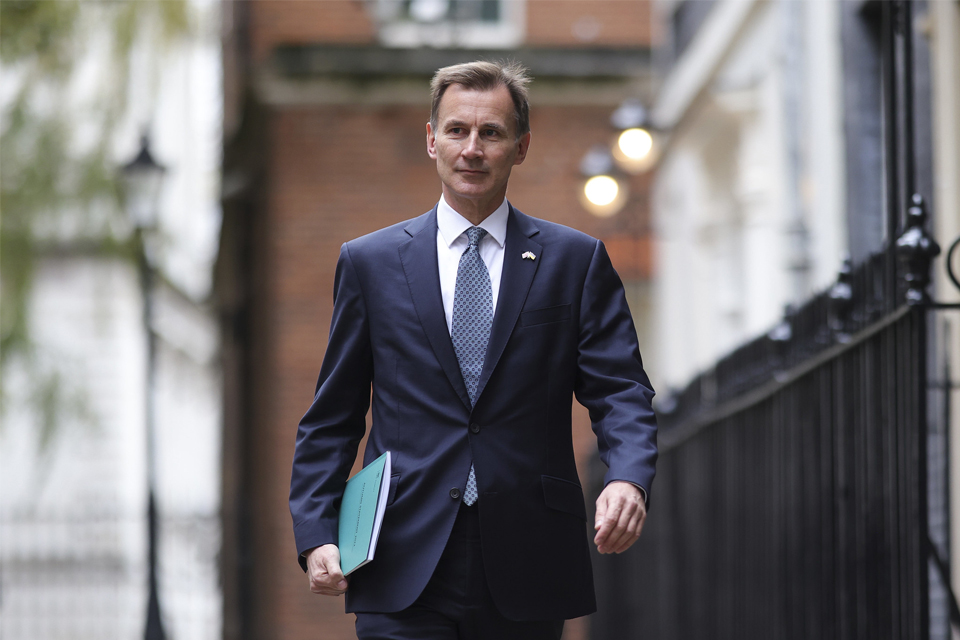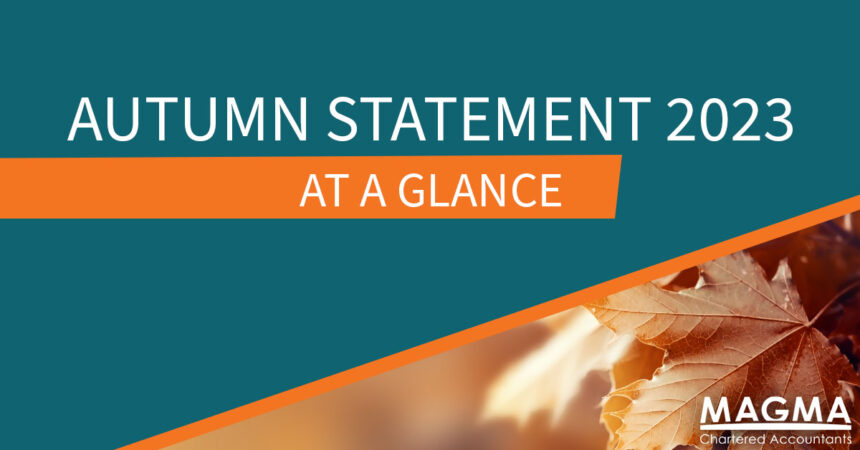A seemingly upbeat Chancellor presented his Autumn Statement 2023, amid much speculation of Tax cuts, and with the latest Office for Budget Responsibility (OBR) forecast predicting little movement of the economy. Whilst some of the predicted cuts didn’t materialise, the sentiment was for a much-needed boost to growth, with a focus on business investment and stimulating employment.
In this summary we provide some details of the tax changes that have been announced that will be of interest to owner managed businesses, entrepreneurs and private clients. We hope you enjoy reading this summary, and if you would like to discuss anything within your own context further, please do not hesitate to get in touch.

Business and Employment Taxes
The Chancellor badged this as a budget for businesses and this was clearly borne out in the announcements made. Businesses of all sizes were given assistance with changes to Business Rates, reductions in self-employed National Insurance costs and a permanent acceleration of capital allowances. Employees will also benefit from a reduction in the rate of National Insurance providing a saving to 27m individuals across the UK.
Full Expensing
What has changed?
As part of the Spring Budget 2023, a temporary measure was introduced to allow companies that incur expenditure on qualifying plant or machinery after 1 April 2023 to claim:
- 100% first-year allowances on main rate expenditure (known as full expensing)
- 50% first-year allowances on special rate expenditure
The Chancellor has removed the temporary nature of the measure (it was originally due to end on 1 April 2026) and made full expensing permanent.
What does it mean for businesses?
Companies within the charge to corporation tax will save 25p of Corporation Tax for every £1 spent on qualifying plant and machinery by deducting the cost of that plant and machinery from their taxable profits in full. Expenditure on plant and machinery used for leasing will remain excluded from the benefits of full expensing together with cars. Companies are also still entitled to an Annual Investment Allowance of £1 million for any assets that do not qualify for full expensing. At a cost of over £10 billion this is reported as the biggest business tax cut in modern British history and the Chancellor was keen to make this known. In reality, Capital Allowances would always have given a tax deduction for the cost of an asset over its life within a company meaning that this change, while welcome, may only represent a timing benefit.
Employment Taxes
What has changed?
- Class 2 National Insurance for self-employed individuals and partnerships has been abolished from 6 April 2024 and those with profits over £6,725 will still receive a credit in the year towards their state pension. Those individuals with profits under £6,725 can choose to make voluntary Class 2 contributions to maintain their state pension credit if they wish.
- Self-employed individuals and partnerships will also benefit from a cut in Class 4 National Insurance from the current rate of 9% to a new rate of 8% from 6 April 2024.
- National living wage to increase by 9.8% to £11.44 per hour from April 2024.
- Employees National Insurance to be cut by 2% to bring the rate to 10%. Emergency legislation is to be introduced to ensure that employees benefit from this reduction from 6 January 2024.
What does this mean for businesses and employees?
For self-employed individuals and those in partnership, National Insurance makes up a significant proportion of the annual tax burden. The Chancellor recognised the benefit that self-employed individuals bring to the economy, particularly during the Covid 19 pandemic, and hopes that a cut to the National Insurance rates would recognise this contribution. This reduction should be welcome news during the ongoing cost of living crisis.
Similarly, the increase to the National Living Wage will be very welcome for affected employees also struggling with the cost of living. However, for businesses with a large workforce of employees paid the National Living Wage, this increase could represent a significant cost that may need to be passed on to customers.
The cut to Employees National Insurance will represent a meaningful saving for 27m employees in the UK and could be worth over £750 per year for those on higher earnings. The cut benefits all individuals that pay National Insurance and is proportionate to earnings meaning that those that pay the most Income Tax and National Insurance will save the most.

Research and Development Tax Relief
What has changed?
Quite a lot! The existing Research and Development Expenditure scheme (RDEC), which is the scheme large companies and some SMEs claim R&D tax reliefs under, and the existing SME scheme will be merged, with expenditure incurred in accounting periods beginning on or after 1 April 2024 to be claimed in the merged scheme.
Merging schemes is viewed as a significant tax simplification by the Government, aligning the qualifying conditions for SMEs and Large companies. The merged scheme will operate like the existing RDEC scheme with an above the line credit and the rate offered under the merged scheme being the current RDEC rate of 20%. For loss making companies, the notional tax rate applied in the merged scheme will be the small profit rate of 19%, rather than the 25% main rate currently set in the RDEC scheme meaning that loss-making companies receive more cash benefit upfront.
The merged scheme will retain some of the more generous aspects of the SME scheme, allowing companies to claim on their contracted-out R&D, allowing large companies to claim for cost of R&D work contracted out for the first time. This is subject to a restriction on relief for overseas expenditure which will come into effect for accounting periods beginning on or after 1 April 2024.
The subsidised expenditure rules in the SME scheme have long been an area of uncertainty for claimant companies and tax advisers alike. In a further simplification, the rules relating to subsidised expenditure will not be carried forward into the new merged scheme which will come as very welcome news. This means that where a company receives a grant covering part of the costs of their R&D, the amount of relief available will no longer be reduced for SME companies.
The Government has retained the enhanced support for R&D intensive SMEs announced in the Spring budget meaning that loss making companies can continue to claim under the SME scheme and a payable credit rate of 14.5% if they meet the definition for R&D intensity. A company will be considered R&D intensive where its qualifying expenditure is 30% or more of its total expenditure. Profit-making SMEs and non-R&D intensive loss-makers will instead be entitled to the new merged R&D scheme.
What does it mean for companies?
The transition to a merged scheme represents the single biggest revision to the UK R&D tax relief incentives scheme since its inception in 2000. On the face of it, a simplified merged scheme feels like a welcome change with specific benefits to both SME’s and Large companies alike. Under the merged scheme the resulting tax benefit is £15 for every £100 of qualifying expenditure, which does represent a worsening benefit for SMEs. However, loss making R&D intensive companies will be able to claim £27 from HMRC for every £100 of R&D investment.
However, the Government appear to have missed the opportunity to improve on the outdated and unhelpfully vague definition of R&D which is contributing to the high level of erroneous claims being made. Further action may still be needed in this regard.
While the merged scheme is designed to be simpler, R&D relief is still a complex area and one in which HMRC are focussing their enquiries. Companies making claims should continue to take proper advice in this area.
Business Rates
What has changed?
Business rates bills are calculated by multiplying the rateable value of a property by either the small business multiplier or the standard multiplier and subtracting any relevant reliefs. The Chancellor announced that he will continue to make sure that support is offered to the small businesses, high street shops and independent cafes and pubs that need it most.
The small business rates multiplier (currently 49.9p for every £1) will be frozen for another year in 2024/2025, while the 75% rates discount for retail, hospitality and leisure will be extended for 2024/2025.
However, the standard rates multiplier for rates (currently 51.2p for every £1) on high-value properties will be increased in line with September’s Consumer Price Index.
These changes will take effect from 1 April 2024 in England.
What does it mean for businesses?
Multipliers usually rise with CPI inflation. Freezing the small business rates multiplier and extending the relief for retail, hospitality and leisure will provide many smaller commercial business owners and tenants a saving while they continue to battle with high costs and wage pressures.
Share Schemes
What has changed?
As previously announced legislation is to be introduced to extend the deadline for registering options granted under the Enterprise Management Incentive (EMI) scheme from the current 92 days to the 6th July following end of the tax year in which the grant was made.
What does this mean for companies?
The new deadline will be aligned with the normal filing date for Employment Related Securities returns thereby reducing the compliance burden and the risk of the current 92-day deadline being missed. The new deadline will only apply for options granted on or after 6 April 2024 so there is still a period in which the current deadline needs to be adhered to.
Enveloped Properties
What has changed?
The Annual Tax on Enveloped Dwellings (ATED) charge applies to residential properties valued over £500,000 within a company (although certain exemptions apply). The annual charge is to rise by 6.7% from 1 April 2024 in line with the Consumer Price Index.
What does this mean for companies?
For companies with such residential properties then the annual ATED cost will increase from 1 April 2024. This extra cost should be budgeted for. There are a number of exemptions from the ATED charge so these should always be explored to see if the cost can be avoided altogether.
Investment Zones
What has changed?
The government will extend the investment zones tax reliefs from five to ten years. This extension is subject to ongoing discussions surrounding the proposals and agreement of delivery plans and will be legislated in 2024.
New Investment zones are going to be opening in Greater Manchester, the West Midlands, and the East Midlands in England, with Wrexham and Flintshire in Wales also allocated as new zones eligible for the generous funding and tax reliefs granted by operating within an investment zone.
What does this mean for businesses?
The current reliefs granted by operating within an investment zone are SDLT relief, 100% business rates relief, 100% first year allowances under the enhanced capital allowances regime, enhanced structures and buildings allowances (10% on a straight-line basis rather than the usual 3%) and a relief on Class 1 National Insurance Contributions on employee earnings up to £25,000 per annum. All of these are in addition to the other usual reliefs available to any incorporated business that does not trade within an investment zone.
Clearly this measure is made to stimulate business investment in special tax sites and create jobs in specific areas of the country.

FOR INDIVIDUALS
Income tax
What has changed?
In his inaugural 2022 Autumn Statement, the Chancellor announced that the personal allowance and income tax higher rate threshold would be frozen until April 2028; perhaps unsurprisingly, we have no deviation from that position.
What does this mean for individuals and owner managed businesses?
- the personal allowance and income tax thresholds continue to be frozen at 2022/2023 levels; the main rates of income tax rates remain unchanged.
- the dividend allowance will be reduced reflecting previous announcements; £500 for 2024/2025; the savings rate limit (£5,000) and Personal Savings Allowance (up to £1,000) remain unchanged.
- the Married Couple’s Allowance and Blind Person’s Allowance will be increased by 6.7%; the Marriage Allowance, conversely, remains unchanged.
Little has changed from an income tax perspective; the reduction in National Insurance (see above) will have a positive impact upon take home pay for those with earned income, with savings of up to £754. The reduction in the dividend allowance tempers that potential upside by up to £200.
Capital Gains Tax
What has changed?
There had been limited press speculation of changes to capital gains tax, perhaps reflecting the changes that had been announced in previous budget statements. No surprises here then when there was no mention of capital gains tax.
What does this mean for individuals and owner managed businesses?
- the annual exempt amount, as previously announced, will be reduced to £3,000 for 2024/2025.
- lifetime limits for Business Asset Disposal Relief and Investors Relief remain at £1million and £10million respectively.
Whilst nothing has fundamentally changed, the maximum rates of 20% and 28% (for residential property gains and carried interests) remain in force, with more attractive rates for entrepreneurs and investors prevailing at 10%.
Inheritance Tax
What has changed?
Much mooted tax cuts were not delivered.
What does this mean for individuals and owner managed businesses?
- the nil-rate band and residence nil-rate band will remain fixed at £325,000 and £175,000 respectively.
- business and agricultural property reliefs remain unchanged.
Despite speculation of significant changes, it is disappointing that proposed reforms and much needed increases to the nil-rate band (which remains unchanged for 14 years) were not forthcoming.
Pensions and Investments
What has changed?
The preannounced measures, this is one area where we do have some changes.
- as previously announced, the lifetime allowance charge will be abolished.
- legislation will be introduced to impose an income tax charge on lump sums exceeding £1,073,100, paid out of pension schemes to pension scheme members, or to beneficiaries of deceased members.
- annual subscription limits for Junior ISAs and Child Trust Fund accounts will remain at £9,000 and the annual subscription limit for adult ISAs will remain at £20,000.
- tax reliefs for Venture Capital Trusts (VCT) and Enterprise Investment Scheme will be extended beyond their current expiry; a new end date of April 2035 has been proposed.
What does this mean for individuals and owner managed businesses?
Individuals who have been restricted on what can be paid into a pension because of the value of their ‘pot’ can realistically add further contributions and benefit from the current tax relief regime. ISA’s continue to offer tax efficient saving and investments as an alternative to the traditional pension.
Tax Administration, Avoidance, and Evasion
What has changed?
- the cash basis will be extended for unincorporated businesses; from April 2024, all business irrespective of turnover, will use the cash basis by default. Current expense and loss relief restrictions will be removed.
- The Government announced the outcome of their review into Making Tax Digital for Income Tax Self-Assessment, which includes design changes to simplify and improve the system when it comes into force in April 2026. A new penalty system will also be introduced for those reporting under this new approach.
- Previously consulted upon tougher restrictions for those that promote tax avoidance will be legislated, including a new criminal offence, and new HMRC powers enabling disqualification action against directors of companies involved.
- The Government is legislating to require employers, company directors, and the self-employed to provide new or improved data to HMRC, from 2025/2026, to enable better outcomes for citizens and businesses.
What does this mean for individuals and owner managed businesses?
Little in the immediate future. Steps are being taken towards simplification and digitalising the tax system; perhaps contradictory measures given the extra administrative burden that will be placed upon taxpayers to report to HMRC more frequently.

The Team
Our experienced and approachable team are on-hand to assist you, please get in touch below:
-
 View profile
View profile
Mark Tuckwell
Managing Partner
-
 View profile
View profile
Andrew Wilson
Corporate Tax Partner
-
 View profile
View profile
David Nash
Private Client Tax Partner
-
 View profile
View profile
Vicki Craig
Audit Partner
-
 View profile
View profile
Luke Turner
Audit Partner
-
 View profile
View profile
Paul Orton
Audit and Business Services Partner
-
 View profile
View profile
Michelle Andrews
Corporate Tax Partner
-
 View profile
View profile
Jon Kicks
Corporate Tax Partner
-
 View profile
View profile
David Buck
Private Client Tax Partner
-
 View profile
View profile
David Hine
Director
-
 View profile
View profile
Jason Bevan
Director
-
 View profile
View profile
Chris Matthews
Senior Corporate Finance Manager
-
 View profile
View profile
Alison Snook
Senior Business Services Manager
-
 View profile
View profile
Graeme Whittall
Senior Business Services Manager
-
 View profile
View profile
Sarah Gray
Senior Tax Manager
-
 View profile
View profile
Luke Edwards
Associate Director
-
 View profile
View profile
Victoria Tunaley
Tax Associate Director
-
 View profile
View profile
Pam Keogh
Tax Associate Director
-
 View profile
View profile
Ryan Parkin
Audit & Business Services Associate Director
-
 View profile
View profile
Matt Norris
Audit Associate Director
-
 View profile
View profile
Rebecca Pallett
Senior Audit & Business Services Manager
-
 View profile
View profile
Liz James
Senior Audit & Business Services Manager
-
 View profile
View profile
Cornelia Petha
Senior Tax Manager
-
 View profile
View profile
Lee Reynolds
Senior Payroll Manager
-
 View profile
View profile
Emma Steptoe
Senior Business Services Manager
-
 View profile
View profile
Andy Summers
Tax Manager
-
 View profile
View profile
Richard White
Senior Tax Manager
-
 View profile
View profile
Liam Meade
Senior Tax Manager
-
 View profile
View profile
Rebecca Mason
Senior Tax Manager
-
 View profile
View profile
James Cornish
Tax Manager
-
 View profile
View profile
Amy Read
Senior Tax Manager
-
 View profile
View profile
Mark Freeth
Senior Business Services Manager
-
 View profile
View profile
Kaylee McCarthy
Senior Audit & Business Services Manager
-
 View profile
View profile
Fiona Porter
Business Services Manager
-
 View profile
View profile
Simon Cantle
Accounts and Business Services Manager
-
 View profile
View profile
Jade Varden
Senior Tax Manager
-
 View profile
View profile
George Wake
Audit & Accounts Manager
-
 View profile
View profile
Sophie Warren
Audit & Business Services Assistant Manager
-
 View profile
View profile
Jaiman Pabari
Audit & Accounts Assistant Manager
